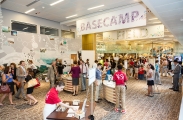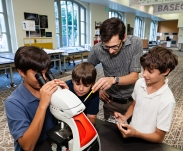 Olympus of Center Valley, PA and The Smithsonian Museum in Washington, DC is unveiling a new first-of-its-kind permanent exhibit in which Olympus has donated over 50 microscopes for teens/tweens to explore the museum’s artifacts. The exhibit, called Q?rius (pronounced “Curious”), a new hub of scientific activity and education based at the Smithsonian’s National Museum of Natural History (NMNH) in Washington D.C. Olympus is supporting Q?rius, the comprehensive 10,000-square-foot experiential learning center, with a donation of dozens of microscopes and imaging systems that will enable museum visitors, along with remote participants, to access more than 6,000 bones, minerals and fossils in the NMNH’s collection and engage in active, ongoing scientific inquiry.
Olympus of Center Valley, PA and The Smithsonian Museum in Washington, DC is unveiling a new first-of-its-kind permanent exhibit in which Olympus has donated over 50 microscopes for teens/tweens to explore the museum’s artifacts. The exhibit, called Q?rius (pronounced “Curious”), a new hub of scientific activity and education based at the Smithsonian’s National Museum of Natural History (NMNH) in Washington D.C. Olympus is supporting Q?rius, the comprehensive 10,000-square-foot experiential learning center, with a donation of dozens of microscopes and imaging systems that will enable museum visitors, along with remote participants, to access more than 6,000 bones, minerals and fossils in the NMNH’s collection and engage in active, ongoing scientific inquiry.
Q?rius is a first-of-its-kind interactive and experimental environment. Through involvement with scientists and interactions with thousands of authentic objects, visitors will experience how science is relevant to them and how they can develop the skills to become the scientists of tomorrow. Q?rius is designed so that students and other visitors will contribute to the world’s body of scientific knowledge and participate in investigating actual research questions by working with actual research objects. A key part of the process is that students, with help from Smithsonian scientists, will use professional-level microscopes and other instruments to probe and study specimens that get them engaged in and excited about the scientific process.
“We are grateful to Olympus for their generous donation of software, accessories, manpower and high quality microscopes to Q?rius,” said Elizabeth Duggal, Associate Director for Public Engagement at the NMNH. “Through their support we are able to offer students the unique opportunity to examine collections using the same scientific instruments that Smithsonian researchers do every day. We’re fortunate to have a partner like Olympus who shares our vision of inspiring the next generation of scientists to become better stewards of our natural world.”
Olympus is contributing significantly by the donation of more than 50 fully loaded, professional scientific microscope imaging systems, along with a variety of cameras, monitors, PCs, stands, software and more. As part of its donation, Olympus is providing a DSX100 opto-digital imaging system, a free-angle wide-zoom microscope that combines cutting-edge optical performance with the operational convenience of a smartphone or tablet. The DSX100 will capture detailed 3D images of specimens for archiving and online access, enabling people to participate in aspects of the Q?rius experience from anywhere in the world. Other key instruments donated include a comprehensive BX63 life science research microscope system equipped with fluorescence and differential interference contrast illumination optics and an advanced research digital camera; a BX53 life science research microscope configured for polarized light microscopy; several BX43 upright compound teaching microscopes, each equipped with five viewing heads for teaching and group observation; and dozens of stereo and dissecting microscopes set up throughout the Q?rius space for use by visitors and school groups. As an added benefit, users will be coached and mentored in using the equipment by Smithsonian scientists and trained educator-volunteers. Along with hardware and software, Olympus is providing extensive staff time for training and support.
“It is an honor to be part of the vital Q?rius program. We are proud to help members of the public participate in the scientific process in collaboration with The Smithsonian, and, through their experience, be inspired to support scientific research and to pursue careers in science,” said Hidenao Tsuchiya, President, Scientific Equipment Group, Olympus Corporation of the Americas. “Olympus has roots in innovation, healthcare and service to humanity that go back nearly a century. Today, supporting science education is one of our top corporate priorities, and we are a natural fit with the goals and challenges of Q?rius.”






Q?rius…”curious” what this is all about? @Olympus and @Smithsonian at @Lehighhappening http://t.co/RMhIzfX0KF
Q?rius partnership @OlympusIMS and @smithsonian at @LehighHappening http://t.co/RMhIzfX0KF